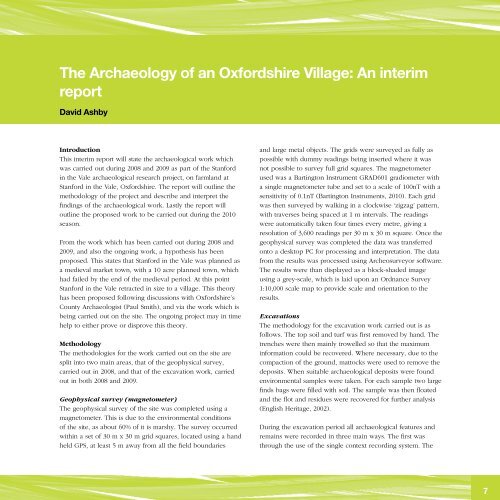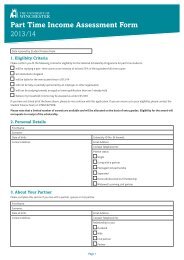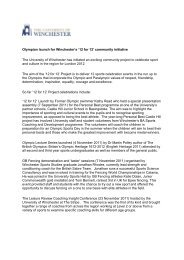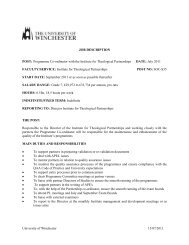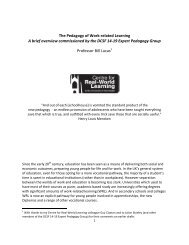alfred 2 - University of Winchester
alfred 2 - University of Winchester
alfred 2 - University of Winchester
Create successful ePaper yourself
Turn your PDF publications into a flip-book with our unique Google optimized e-Paper software.
The Archaeology <strong>of</strong> an Oxfordshire Village: An interim<br />
report<br />
David Ashby<br />
Introduction<br />
This interim report will state the archaeological work which<br />
was carried out during 2008 and 2009 as part <strong>of</strong> the Stanford<br />
in the Vale archaeological research project, on farmland at<br />
Stanford in the Vale, Oxfordshire. The report will outline the<br />
methodology <strong>of</strong> the project and describe and interpret the<br />
findings <strong>of</strong> the archaeological work. Lastly the report will<br />
outline the proposed work to be carried out during the 2010<br />
season.<br />
From the work which has been carried out during 2008 and<br />
2009, and also the ongoing work, a hypothesis has been<br />
proposed. This states that Stanford in the Vale was planned as<br />
a medieval market town, with a 10 acre planned town, which<br />
had failed by the end <strong>of</strong> the medieval period. At this point<br />
Stanford in the Vale retracted in size to a village. This theory<br />
has been proposed following discussions with Oxfordshire’s<br />
County Archaeologist (Paul Smith), and via the work which is<br />
being carried out on the site. The ongoing project may in time<br />
help to either prove or disprove this theory.<br />
Methodology<br />
The methodologies for the work carried out on the site are<br />
split into two main areas, that <strong>of</strong> the geophysical survey,<br />
carried out in 2008, and that <strong>of</strong> the excavation work, carried<br />
out in both 2008 and 2009.<br />
Geophysical survey (magnetometer)<br />
The geophysical survey <strong>of</strong> the site was completed using a<br />
magnetometer. This is due to the environmental conditions<br />
<strong>of</strong> the site, as about 60% <strong>of</strong> it is marshy. The survey occurred<br />
within a set <strong>of</strong> 30 m x 30 m grid squares, located using a hand<br />
held GPS, at least 5 m away from all the field boundaries<br />
and large metal objects. The grids were surveyed as fully as<br />
possible with dummy readings being inserted where it was<br />
not possible to survey full grid squares. The magnetometer<br />
used was a Bartington Instrument GRAD601 gradiometer with<br />
a single magnetometer tube and set to a scale <strong>of</strong> 100nT with a<br />
sensitivity <strong>of</strong> 0.1nT (Bartington Instruments, 2010). Each grid<br />
was then surveyed by walking in a clockwise ‘zigzag’ pattern,<br />
with traverses being spaced at 1 m intervals. The readings<br />
were automatically taken four times every metre, giving a<br />
resolution <strong>of</strong> 3,600 readings per 30 m x 30 m square. Once the<br />
geophysical survey was completed the data was transferred<br />
onto a desktop PC for processing and interpretation. The data<br />
from the results was processed using Archeosurveyor s<strong>of</strong>tware.<br />
The results were than displayed as a block-shaded image<br />
using a grey-scale, which is laid upon an Ordnance Survey<br />
1:10,000 scale map to provide scale and orientation to the<br />
results.<br />
Excavations<br />
The methodology for the excavation work carried out is as<br />
follows. The top soil and turf was first removed by hand. The<br />
trenches were then mainly trowelled so that the maximum<br />
information could be recovered. Where necessary, due to the<br />
compaction <strong>of</strong> the ground, mattocks were used to remove the<br />
deposits. When suitable archaeological deposits were found<br />
environmental samples were taken. For each sample two large<br />
finds bags were filled with soil. The sample was then floated<br />
and the flot and residues were recovered for further analysis<br />
(English Heritage, 2002).<br />
During the excavation period all archaeological features and<br />
remains were recorded in three main ways. The first was<br />
through the use <strong>of</strong> the single context recording system. The<br />
7


